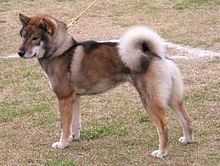| This article needs additional citations for verification. Please help improve this article by adding citations to reliable sources. Unsourced material may be challenged and removed. Find sources: "Shikoku dog" – news · newspapers · books · scholar · JSTOR (March 2010) (Learn how and when to remove this message) |
| Shikoku Ken | |||||||||||||
|---|---|---|---|---|---|---|---|---|---|---|---|---|---|
 | |||||||||||||
| Other names | Kochi-ken Tosa Ken Tosa Inu | ||||||||||||
| Origin | Japan | ||||||||||||
| |||||||||||||
| Dog (domestic dog) | |||||||||||||
The Shikoku Ken (四国犬, Shikoku-ken) or Kōchi-ken (高知犬) is a Japanese breed of dog from Shikoku island. It was designated a living national monument of Japan in 1937 Tosa Inu. However, because this could lead to it being confused with the Tosa Fighting Dog, and the breed was also found in other prefectures, from around 1932 it was referred to as the Shikoku Ken.
The Shikoku Ken is one of the medium-sized large game hunting dogs native to Japan, originating from the mountainous island of Shikoku where they were prevalent hunters of deer, boar and other indigenous wildlife. They are typical of other Japanese spitz-type hounds with a dense and harsh coat, erect ears, and a tail that is held over their back. They are a nimble and spirited dog with sharp senses and a keen intuition capable of becoming an ardept hunter, watchdog, or companion.
Being a rare breed, one might only ever see it in its native homeland, Japan. The Shikoku Ken's numbers are in gradual decline, similar to the fellow Nihon Ken Hozonkai breed Kishu Ken. Without dedicated enthusiasts, these breeds may soon disappear completely.
The Shikoku Ken is listed as a Foundation Stock Service breed with the American Kennel Club and is fully recognized by the United Kennel Club.
Comparison to other Japanese breeds
The Shikoku is one of the six native Japanese breeds, it is intermediate in size between the large Akita Inu and the small sized Shiba Inu; all are within the Spitz family of dogs.
A study of the 1930s carried out by the Japanese cynologist Haruo Isogai classified all native Japanese dog breeds into three categories: large-, medium-, and small-sized. The Shikoku belongs to the Shika-inus, the medium-sized dogs. Other medium-sized dogs are the Kai Ken, the Ainu Ken and the Kishu Ken.
Characteristics and temperament


Standard sizing should be 20.5 inches (52 cm) for males and 19 inches (49 cm) for females. A tolerance of 1.25 inches (+3 cm)in either direction is permitted. Sexual dimorphism between males and females is evident in both the expression and the body type. The body is strong and muscular and always shown in working condition without excess weight. The ratio is slightly longer than tall at 10:11. The Shikoku has 5 coat colors: red, red sesame, sesame, black sesame, & black with tan points. In addition, there is a cream colored coat that is rarely seen as it is not an accepted color in the breed. In all of these colors there are pale markings on the ventral portion of the dog known as "Urajiro", and should be visible on all coat colors. These markings lie along a similar pattern to tan points on a black dog: in the eyebrow, on the side of the muzzle, on the cheeks, on the underside of the jaw, on the paws and the inside of the legs, and under the tail.
Varieties
Out of the reconstruction effort, three distinct lines of the Shikoku were developed: the Awa, the Hongawa and the Hata all named after the area they originated from within the Kochi prefecture. More recently the distinction between these lines has been blurred as remote areas where the dogs originated became easier to access and lines were cross-bred. The modern Shikoku is thought to descend mainly from the Hongawa and Hata lines as the Awa line essentially disappeared as a result of the hardships caused by World War II and a lack of quality specimens due to cross breeding with outside dogs.
See also
References
- ^ FCI Breed Standard
- FCI Breed standard
- JKC breed standard
- Haruo Isogai was a dog breeder who worked up a classification system for Japanese dogs based on appearance, as a nationalist response to the adoption by dog enthusiasts in Japan of European breeds in the 1930s. ( Archived 2022-09-24 at the Wayback Machine in Dutch) ("Zaras-Traumwelten - Russischer Traber". Archived from the original on 2009-04-06. Retrieved 2008-04-12. in German) There is no evidence that he had any relevant scientific training or even that he ever called himself a "cynologist".
- "North American Shikoku Club » the North American Shikoku Ken Club (NASC) | Breed History".
External links
| Dogs originating in Japan | |
|---|---|
| |
| See also: Japan Kennel Club • Nihon Ken Hozonkai |